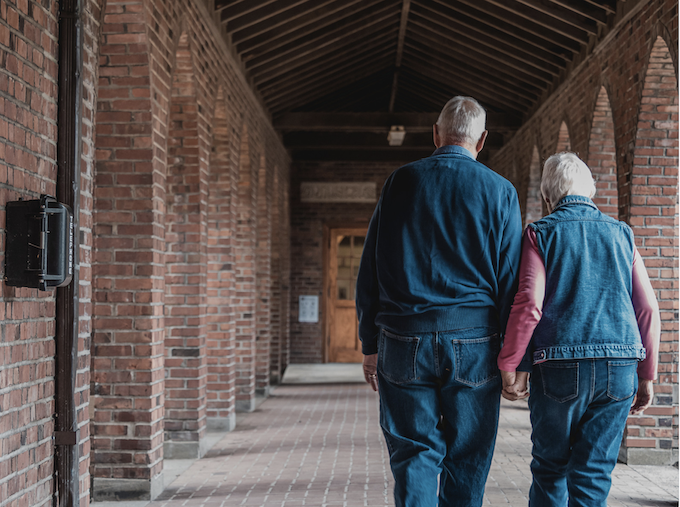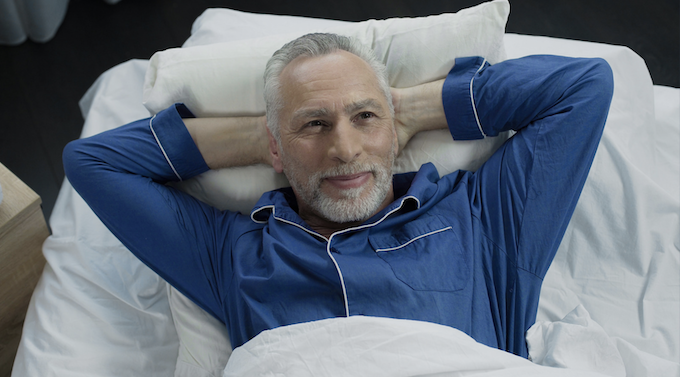If you have just had or will soon have a knee replacement you want to know all of the movements that you can and can't do. There are many misconceptions that lead some people to do too much and others to do too little. The purpose of this blog is to help you understand all of the safe and unsafe movements after a knee replacement.

Image by Sofia Shultz via Canva. One movement that you need to avoid after a knee replacement is twisting when walking.
Twisting
There are certain movements and positions that need to be avoided to make sure that your new knee replacement lasts and that you don't have an injury. One movement that you need to avoid during your recovery is any sudden twisting at the knee joint. Sudden twisting at the knee joint will put strain on the joint and ligaments still surrounding the joint which may lead to injury.[6] A good tip to follow is when you are walking, always keep your toes and knee pointed in the same direction as your nose! If you are reading this, get up and give it a try, it will ensure that you are not twisting at the knee joint. When turning to change directions, try to take small steps and avoid turning or rotating on the foot in which your knee is recovering.

Image by motortion via Canva. During the four to six weeks after your knee replacement, you should avoid sleeping with a pillow or towel underneath your knee.
Sleeping
A position that you will need to avoid during the first four to six weeks after surgery is one when you are sleeping. One of the goals of rehabilitation after a knee replacement is to regain your knee bending and straightening.[4] This will help you return to your activities of daily living. You may ask “what does this have to do with sleep?” Well after the knee replacement surgery, it is quite common to have pain and swelling around the area. This might make it difficult to fall and stay asleep. One strategy that many people have used is to put a pillow or towel underneath the knee in order to relieve some of the pain and discomfort. Do not put a pillow or towel under your knee! Using a pillow or towel will put your knee in a slightly bent position, which will lead to stiffness the next day making it difficult to move the knee. Repeated use of a pillow under your knee may lead to a flexion contracture, which means your leg may stay in a bent position even when you are trying to straighten your knee and you may need another surgery to fix this very avoidable issue.[4] To make sure that your leg is fully straightened while sleeping, you can put a pillow or towel underneath your ankle or heel but not under your knee.

Image by Greta Hoffman via Canva. Kneeling is required for many daily activities and is a common goal after knee replacement.
Kneeling
The ability to kneel is a common goal for the majority of people after a total knee replacement.[7] Why?.. Take a moment to think about all the activities that require you to kneel? The list is pretty extensive, but here are some activities that come to mind:
- Household activities (cleaning, reaching items in low cupboards, decorating,gardening,eating meals)
- Getting up after a fall (falls are unfortunately common after a knee replacement)[7]
- Social participation (playing with your children or grandchildren)
- Self care (using the toilet, getting out of the bathtub)
- Religious activities (such as kneeling for praying)
Interestingly people's ability to kneel is not the same as what the research shows is safe after a knee replacement. For the most part people think they are more limited than what the research shows is safe in terms of kneeling. What this means is that the majority of people who thought they couldn’t kneel after surgery, were able to kneel (and quite easily). So why is it that people think they can’t kneel? Well to state the obvious, it's the pain associated with the movement, along with other factors such as fear of damaging the new knee.[7] However, previous research has been conducted on the movement of kneeling after a knee replacement and has found that it is highly unlikely that kneeling will move the new knee implant out of place.[1] [3] So, is it safe to kneel? Yes, it is! Some recommendations however to keep in mind are:
- Experiencing some pain while kneeling is okay, it is part of the recovery process. For an overview of pain, the blog “Should I be experiencing pain when I do my rehabilitation exercises” is a great guide to explaining pain and what it means.
- Kneel on a soft surface to protect the healing skin around the area of surgery: This can introduce bacteria into the wound and potentially cause infection.[7]
"Can I kneel after a knee replacement?” mentioned that an adequate range of motion was also needed in order to kneel. This means that your knee needs to be able to comfortably bend back enough to get into a kneeling position. This brings us to the next movement on the list.

Image by monkey business images via Canva. After a knee replacement, you should wait until your knees are able to bend enough to sit cross legged.
Crossing your legs
This unfortunately is a yes and no answer, and I am not a big fan of these types of answers, but here is why. Shortly after your total knee replacement, it is not recommended that you cross your legs. This is most likely due to the lack of range in your knee to be able to cross your legs. If you have ever seen someone sitting cross legged, you know how much their knee needs to bend. If you haven't, take a look at the picture above. Days after surgery, if you try to force your leg into this position, you risk injury to the knee. Crossing your legs requires an extreme amount of bend in the knee, however, it is not impossible to be able to once again cross your legs.[2] After appropriate rehabilitation to regain knee flexibility, just like kneeling, it is safe to cross your legs. You also must keep in mind that your ability to bend your knee after surgery is dependent on many factors.[5] One of those factors is the amount you were able to bend your knee before the surgery. If your knee was not flexible before surgery, according to research, there will be less flexibility after your knee replacement.[5] With that in mind, if you were unable to sit cross legged before surgery, it is highly unlikely you will be to cross your legs after surgery.
Conclusion
After your knee replacement surgery, there are movements and positions that you can and can’t do. You should avoid twisting and sleeping with a pillow underneath your knee. Twisting movements may lead to injury of the joint. Sleeping with a pillow underneath your knee will lead to stiffness and may cause future problems. Avoid this for about four to six weeks. You can kneel and cross your legs, but this depends on how far you are in your recovery as you need your knee to bend quite a bit for you to complete these positions.
Curovate can help you if you have had a knee replacement surgery to help guide you during your rehabilitation process and get you back to enjoying the activities you love. Download our knee replacement recovery app today to get started on your recovery!
If you need further customized assistance during your surgery or injury recovery check out our Virtual Physical Therapy page to book your 1-on-1 video session with a physical therapist.
 |
 |
|---|
Other Blogs Related to Knee Replacement Recovery
- What is the Recovery Timeline for a Total Knee Replacement?
- Is it normal to still have pain after a knee replacement surgery?
- What is range of motion and why is it important following knee replacement? - ROM:Part 1
- 6 Things You Need to Know After A Total Knee Replacement
- What kind of Exercises and Sports can I do after a Total Knee Replacement
- Why does my knee feel weird after my total knee replacement? Why does my knee feel heavy after my total knee replacement
- Should I exercise before my total knee replacement?







